Garlic is one of the most useful vegetables, which is always in any house. It is used in cooking, in the treatment of various ailments, for tinctures and rubry. Thanks to its healing properties, this wonderful vegetable is widely used in traditional medicine. And, perhaps, there is not a single gardener, who would not have a bed to bed on her household plot. After all, it is always convenient to have this culture at hand and use as needed. And in the technology of planting garlic and its cultivation there is nothing complicated, even a newcomer in garden matters will cope with it.
In this article we take a closer look at the features and garlic description, define its basic types and the most popular varieties. And also tell you how to plant a winter and spring garlic, remove it and save all their beneficial properties.
Features and description garlic
Garlic is a herbaceous perennial plant that belongs to the family Amaryllidaceae and is a member of the genus Onion. Garlic is known to almost every inhabitant of our planet, thanks to its specific smell and taste. This vegetable crop known to mankind for more than 5000 years old and still has not lost its popularity.
Garlic is home to Central Asia, this is where the cultivation of this vegetable. The whole world has received a large number of varieties of garlic from Tajikistan, Uzbekistan, Turkmenistan, Afghanistan and Pakistan. Many scientists proved that garlic originated from dlinnoostrokonechnogo onions, grown on these areas.
The history of the use of garlic is so old that there are references to it in ancient India, ancient Rome and Egypt. At that time, he served as an important component of improving the diets of ancient Egyptians, it was a part of essential medicines. During the excavation of the remains of the Egyptian pyramids of garlic have been found, indicating the features of its ritual use in those days. Today, the cultivation of garlic is very important, since it is an integral component of various foods and medications.
garlic Description:
- Garlic is a perennial herbaceous plant,. It took place on the bow, it is therefore considered a vegetable crop.
- The root system is underdeveloped garlic, fibrous, located close to the surface. Therefore, a soil nutrient mixture landing this culture.
- Head of garlic round shape, the size is different - it all depends on the particular variety. Approximately one bulb weight can vary from 20 to 50 grams, which is 3-6 cm in diameter.
- Bulb flattened on two sides.
- The flakes are formed axils children, an average of from 2 to 50 children or so-called teeth.
- Garlic cloves covered with white, yellowish, purple, pink scales.
- The leaves of garlic are long and narrow, with a groove in the middle. There are drooping and erect, and 100 cm in length.
- All the leaves grow one single, thus forming a false stem.
- From the center of the false stem grows a long blooming, which can reach 150 cm long.
- At the end of the flower, an umbrella inflorescence is formed, from which the fruit appears in the form of a box.
- Garlic is overpressure and Yarov. Such a classification is built on the basis of landing time: winter sits in the fall, and spring - spring.
Main types and varieties of garlic
Total distinguished two types of garlic: winter and spring. They are distinguished by the landing time, the peculiarities of the appearance and the duration of storage. There are a large number of garlic of two these species, which to a greater or lesser extent won the calling and love of gardeners. Let us consider in more detail the features of the species and varieties of garlic.
Winter garlic
- Differs on earlier maturation of the bulbs.
- Always gives a big harvest.
- Garlic heads are quite large, consisting of a small amount of teeth. In one bulb may be no more than 10 teeth.
- The main lack of winter garlic is unimportant storage. It is recommended to use immediately in the latest form or for conservation.
- Winter garlic is multiplied with cloves and bulb bulbs.
- Garlic landing is carried out in the fall.
Popular grade of winter garlic:
- Sort "Komsomolets". The bulb is quite large, some copies can reach weights at 25-30 grams. On average, one head can accommodate from 8 to 13 teeth. The whole bulb is covered with pinkish purple scales. Refers to short-lived varieties. Sufficient enough, it is distinguished by a sharp taste.
- Grade "Boguslavsky". The bulbs of this garlic variety have a spherical shape. On average, the weight of one bulweic reaches 45 grams. Differs in a small number of teeth in the head - only about 6 pcs. The bulb is covered with a lilac gray scales. The grade of garlic "Boguslavsky" is peculiar to good cold resistance.
- Grade "Mushroom Jubilee". Garlic of this variety is characterized by a large size. One bulb on average can reach up to 40 grams. A head of a large amount of teeth is from 10 to 13. The bulb is covered with purple scales. This variety belongs to the most acute taste, and also boasts good resistance to cold and disease. Fight grade of winter garlic, which gives a big crop.
- Grade "Mushroom 60". This variety belongs to the early and has excellent endurance towards poor weather conditions. Fight grade. Like the anniversary, it is distinguished by a very sharp taste and aroma. A fairly large bulb, which consists of 6-12 teeth.
- Grade "Otradnensky". This grade of winter garlic is perfect for planting in cooler territories. It has a very sharp taste and sufficiently large bulbs, which consist of large teeth in an amount of from 3 to 6. The bulb surface is covered with purple scales.
- Grade "Losevsky". This grade of winter garlic is distinguished by high yield and excellent endurance. Refers to sterling varieties. The bulb is quite large, on average, the weight of one can reach 80 grams. It consists of a small amount of teeth - only 4-5 pcs.
- Grade "Gulliver". Judging by the title, the bulbs of this grade of garlic differ in very large sizes. The weight of one head can achieve in a weight from 90 to 120 grams. This variety has an incredibly sharp taste.
Skar garlic
- Unlike winter, spring garlic landed into the open ground in early spring.
- It also has very good resistance to cold and can tolerate small frosts.
- Spring garlic does not release the arrows, only one variety is characterized by this ability - Gulliver.
- This type of garlic is multiplied by cloth.
- The bulbs of spring garlic is significantly less than that of winter. However, it contains much more teeth - on average in one head can be up to 30 pcs.
- All teeth in the bulbs are located on the spiral, near the center are the smallest.
- Spring garlic has a smaller harvest, but its main feature is excellent storage.
Popular varieties of spring garlic:
- Variety "Degtyar". In terms of maturation refers to mediterranetes. To taste, this grade of garlic is not very acute. Heads are small, but contain a large number of teeth - from 16 to 18 pcs.
- Victorio variety. This variety is highly harvest. On the shape of a bulb slightly rounded, consist of about 13-15 teeth. The weight of one head on average reaches 40 grams. Taste refers to the peninsula. The surface of the bulbs is covered with white with yellow scales.
- Grade "Gulliver". This variety is the only one among the yarns, which releases the arrow. Differs in high yield and large size of bulbs. One head can weigh up to 120 grams, while containing only 4-5 teeth. It can be attributed to sharp varieties.
- Grade "Elena". According to yield, this variety can be attributed to average, but consistently good. Bulbs are dense, small in size. The weight of one head can reach 25 grams. On average, it contains 15-18 teeth that are covered with a scaled cream shade. The entire surface of the bulb has a dirty white color.
Landing of winter garlic in open ground
Landing of winter garlic and spring has some differences and features that need to be taken into account to obtain a rich yield of the useful vegetable. Consider the nuances of growing every kind of garlic separately.
When planting winter garlic
The main thing in getting a good crop garlic is the choice of the right landing time. After all, if you do not guess, the garlic can freeze and will not have time to create a strong root system, or the sprouts will start too early. Planting garlic under winter is carried out in the fall. It is also important to guess with a specific landing time. You must remain about 1.5 months before the onset of sustainable winter frosts. In medium latitudes, this is somewhere the second half of September or the beginning of October. The soil temperature at this time should be 12-15 cm. Before the appearance of snow cover and severe frosts, your garlic must have time to form a strong root system about 10 cm long. And this is the key to the future harvest.
Preparation of garlic planting material
To obtain a rich and nutritious harvest of garlic, it is necessary to choose a healthy and high-quality planting material, as well as choose suitable varieties. Prefer regional varieties that feel great in your climatic conditions and consistently give a good harvest.
- The garlic of winter grades loves drying in the sun. Therefore, be sure to break it before planting.
- Next, divide all the bulbs on the teeth.
- Mandatory all seating should be sorted. It is important to remember that it is possible to get a big harvest only from healthy and strong teeth. Therefore, reflect only whole and large enough to land.
- Winter grades of garlic on the diacon there is a peculiar plug that can slow down the germination of garlic. It must be removed.
- All teeth can be treated with a special solution purchased in the store, or by the usual solution of manganese.
Soil preparation before landing garlic
Winter garlic prefers to grow on a loamy nutrient soil, which is not too overcooked. The optimal place for planting this culture is the open and sunny plot on a small elevation.
You will have to prepare the beds for landing. It must be done about 2-4 weeks before landing garlic in open soil. Typically, the beds are prepared in place, where other vegetable cultures grew before that. The best predecessors for garlic are any kind of cabbage, beans, zucchini, pumpkin. It is not desirable to plant garlic, where onions, carrots, cucumber, tomatoes or garlic grew before that.
The bed must be carefully accurate and make a small elevation. During this process, you can add fertilizers. As a preset feeder, it is recommended to use humid, superphosphate and potassium.
The process of planting winter garlic cloths
- At the prepared pre-gardening, the grooves must be made for planting.
- Winter garlic must be planted significantly deeper than spring. Approximate depth of planting cloves of garlic - 15-20 cm.
- At the bottom of each groove, pour a layer of wood ash with a thickness of approximately 3 cm. It is necessary to prevent contact of the tooths with the soil, which can lead to pawing.
- It is also important to consider the landing scheme, since large and smaller garlic cloves are planted at different distances from each other. The distance between large teeth should be 12-15 cm, between small - 8-10 cm.
- Also consider the distance between the ridges. It should be 20-25 cm.
- After landing garlic, all the beds need to be closed, which will create additional protection during winter frosts. As a mulch, use a dry peat, a mixture of sawdust, hay.
- You also need to pour garlic after landing.
- To prevent the freezing of garlic, you can cover the garden rinkeroid or film.
Landing winter garlic with air bulbs
Winter garlic is fighting and unstring. Some varieties give arrows with inflorescences on the top, which after ripening become air bulbs. These bulbs are also suitable for breeding garlic. These bulbs are formed in the beds in about June. Usually if you want to get a crop of big garlic, then these inflorescences need to trim. In case you want to use air bulbs as a landing material, you must wait for their full ripening - the buffet of the inflorescence and the bulb will become the color of varietal garlic.
- The escaped garlic with an air bulb must be carefully dried.
- Then it is necessary to free all the bulbs from the scenery of inflorescences and subject them to sort. Select only the largest and healthy.
- Such bulbs are planted in early September or in mid-October, as well as ordinary garlic. As a result, in the summer you will get a single-building-north, suitable for breeding and updating the planting material to obtain a good crop of garlic.
- For landing, prepare a garden with a height of 10-15 cm and a width of no more than 90 cm.
- The bed must be switched and focus with a humorier and compost. Everything must be carefully close.
- On the prepared Groke, make small grooves at a distance of 10 cm from each other.
- The bulbs need to be planted at a depth of 2-3 cm and observing the distance between them in 1-2 cm.
- The grooves are sprinkled with soil and murdered.
Growing of spring garlic in open soil
The cultivation of spring garlic is practically no different from the process of obtaining winter, however there are some nuances that are peculiar only to this kind.
When planting spring garlic
To get a large harvest of spring garlic, it is important to choose the right time for landing. This type of garlic has a rather short time of vegetation, so it is important to put it as early as possible. Only in this case can you get an adult for a short summer and formed garlic bulb. The optimal temperature of the soil for planting of spring garlic in the open ground should be 4-5 degrees. By time it is about the beginning or mid-April. It is important to remember that only under reduced temperatures of spring garlic forms the root system. If you skip this period, you can get a rather meager harvest.
Preparation of planting material
Only cloves are used to obtain spring garlic.
- Preparation depends on the method of storing spring garlic. If you kept it in a warm room, then the crop will be larger, but it will be longer to mature. With cooler storage of the bulbs, it turns out less in size, but they ripen much faster.
- To obtain a harvest of large garlic in a fairly rapid duration of the bulb, it is necessary to keep some time at room temperature, and then place it in a cold place. For example, in the refrigerator. This is the process of stratification, which lasts 2 months.
- After that, the bulbs understand the teeth.
- They need to be sorting and select the most healthy and strong.
- Yarovoy garlic cloves need to be cleaned of scales. Do it before the landing itself, as the teeth do not have to dry the Donets.
- For a faster rooting of the teeth, the planting material can be treated with a solution of manganese and wrap in a wet fabric. After that, place everything in the package and leave for a few days. This process is called germination.
Soil preparation for landing of spring garlic
You need to prepare the soil for planting a spring garlic in the fall, since the early spring earth does not fully thaw. For landing, a loamy soil with a neutral reaction is perfectly suitable. It is important that there is no water stagnation. For this, bedding can be made on a small elevation. The place must be sunny and open.
Grokes need to be carefully overcooked and added to the soil 1 bucket of humus and wood ash. You can replace asha to complex mineral fertilizer.
The process of planting a spring garlic in an open ground
- Prepared beds before the landing need to be exploded.
- Next prepare the grooves, a depth of about 2-3 cm.
- At the bottom of the grooves, it is necessary to place a layer of ash, which will prevent the contact of the tillers with the soil.
- Targeted garlic landing scheme: 6-8 cm between cloths and 20-25 cm between rows.
- Next, the tooths fall asleep the earth and spring garlic watering water.
- After that, the soil is to be meditated to prevent the moisture evaporation. As a mulch, use a dry peat.
Garlic care features
To obtain a rich harvest of such a useful vegetable, it is necessary to comply with all nuances of care for spring garlic and see. Caring for this culture is a timely and rather abundant irrigation, in the feeding and timely loosening of the soil, as well as in the proper cleaning and storage of garlic.
Watering garlic
Garlic needs very abundant irrigation. It is important to comply with the correct soil moisture mode, as this will directly affect the quality of the future harvest. At the beginning of the vegetation of garlic of any kind of watering is needed very abundant. This is about 10-12 liters of water per 1 sq.m. Crickerel. Next, during the ripening of bulbs, watering is reduced. And it can even stop in August, otherwise there is a risk of rotting garlic. Also, when an excessive amount of water increases the risk of disease.
Loosening and mulching garlic
Periodically, the beds with garlic need to loosen and remove weeds. This is usually done the day after watering. To reduce the number of weeding, can soil the beds zamulchirovat. This will not only reduce the amount of weeds, but also will save your garlic from the evaporation of moisture in particularly hot days. The mulch may be used as dry peat. You can pick up a lighter mulch, such as sawdust. Also care of winter garlic includes arrows pruning to increase the yield of garlic.
Top dressing of garlic
Garlic for the entire season fertilize about 4 times.
- First fertilizing is introduced after the first shoots. As fertilizers can be used nitrogen fertilizer or mullein. For example, 10 liters of water can dissolve 1 tbsp urea cup mullein.
- The second top dressing is carried out in 10-14 days after the first and nitrogen fertilizers.
- When begin to form bulbs of garlic, they need to feed the potassium and phosphate fertilizers (superphosphate, potash).
- Exactly the same and the fourth dressing of garlic, which is carried out 2 weeks after the third.
Fighting against diseases and pests of garlic
garlic diseases:
- rot;
- bacterial rot;
- powdery mildew;
- black mold;
- white rot.
To combat all diseases can use special preparations - fungicides. However, we must remember that garlic can absorb not only useful and nutrients, but also chemicals. Therefore it is necessary to refrain from the use of these funds. The emergence of disease prevention is better properly caring for culture.
pests:
- onion fly;
- onion thrips;
- root mites;
- onion nematodes;
- garlic mite.
Typically, to combat the pests using insecticides. However, as in the case of diseases, it is better to avoid the use of chemicals. Folk remedies can be used, e.g., to combat fly applied salt solution.
Cleaning and storage of garlic
An important stage of care - cleaning and storage of garlic. Time to remove the garlic - then keep the whole bulb.
- 10-14 days before harvest should stop watering.
- Garlic is carefully digging, since the ejection, you can damage it.
- Clean the bulbs from the ground, but the leaves are not impossible to cut. During drying, all of the nutritional juices from the leaves go into the bulb.
- The first 4-5 days the garlic is dried in the sun, but at night you need to enter the premises. Further, the garlic is bound in small bunches and hung in a dry place.
- Keep your garlic needed in a dry place. There are two storage options: cold and warm. When cold storage, the temperature is 1-3 degrees, and with heat - 20-25 degrees. The future harvest will depend on the type of storage, which we have previously told.
Garlic is a culture that does not require much difficulty when growing. Even newcomer can cope with this process. The main thing is to pay attention to garlic beds and in the end you will get a rich harvest of the useful vegetable.

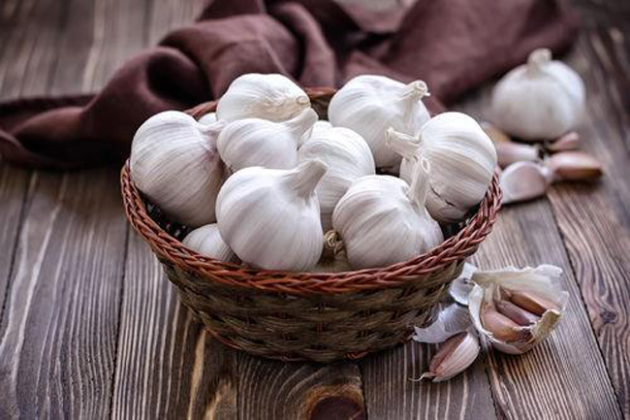
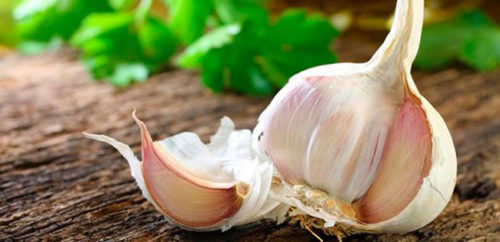
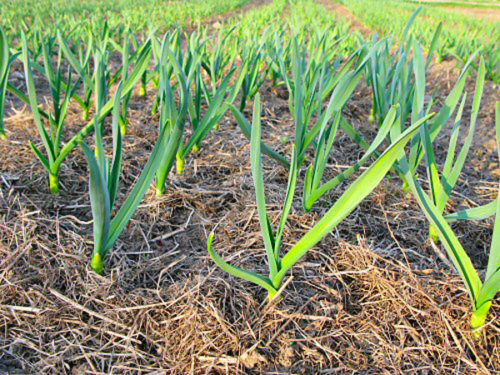
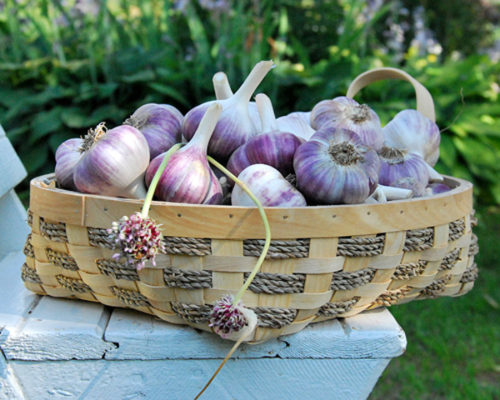
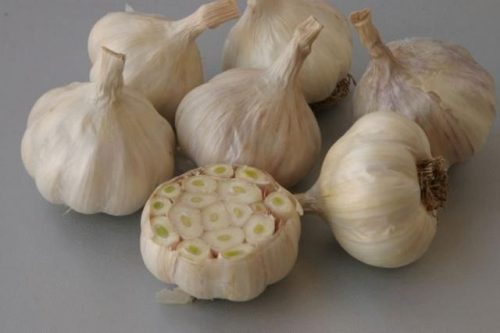
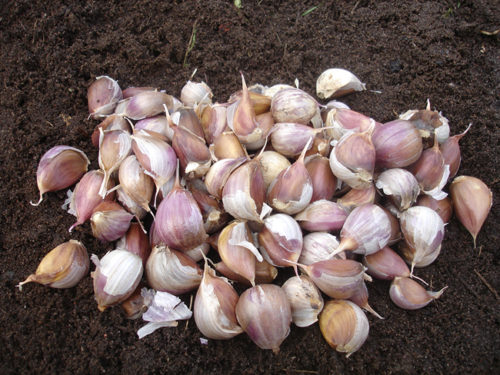
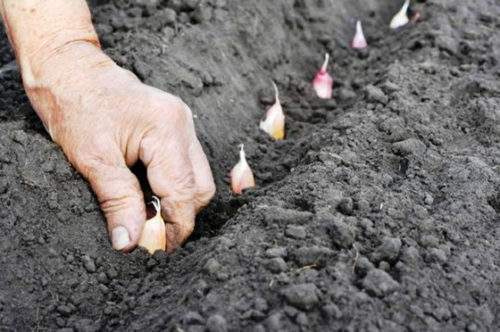

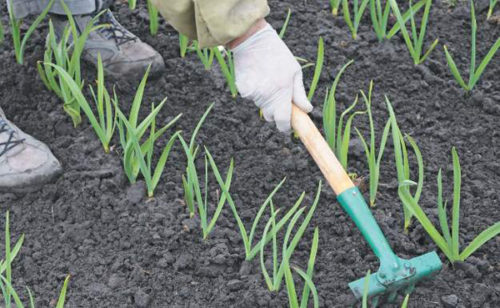
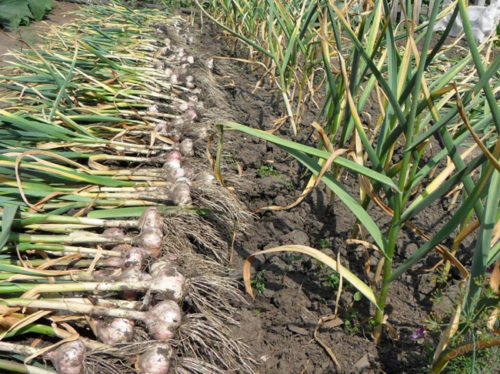












 Start a discussion ...
Start a discussion ...